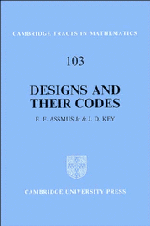3 - The geometry of vector spaces
Published online by Cambridge University Press: 05 October 2015
Summary
Introduction
The projective and affine geometries of finite-dimensional vector spaces over finite fields provide the deepest source for the theory of designs. Recreational mathematics, the configurational aspects of classical geometry, and the needs of statisticians in the designing of experiments provide other sources, but much of the motivation and direction for the study of designs comes from geometry and it gives us also a wealth of examples that are easily grasped and well understood. This body of examples and theory has grown so extensive that it has earned a place and a name as a mathematical discipline: it is generally referred to as finite geometry.
Chapter 5 discusses the codes — and their important properties — of the designs coming from finite geometries. In Chapter 6 we employ these codes to discuss a theory of projective planes. For now we use the finite geometries to construct our first and most important infinite classes of designs. We will obtain designs from both projective and affine geometries and, as might be expected, they will be rather closely related.
Let F be a field and V a finite-dimensional vector space over F. Then PG(V) denotes the projective geometry of V. Its elements are the subspaces of V and its structure is given by set-theoretical containment. Similarly, AG(V) denotes the affine geometry of V. Its elements are the cosets, x+U, of subspaces U of V, where x is any vector in V, and again the structure is given by set-theoretical containment. The “geometry” of these structures arises through viewing containment as an incidence relation. We will not be considering the general synthetic definitions of projective and affine geometry, except in the case of planes (see Chapter 6). An account of the synthetic development attuned to our purposes here can be found in Dembowski [85, Section 1.4] but, of course, in many other standard references also.
We clearly cannot do justice to the vast subject of the geometry of vector spaces in a single chapter of a monograph. We will give a basic outline that will be sufficient for our development and refer the reader to the literature for more complete treatments.
- Type
- Chapter
- Information
- Designs and their Codes , pp. 89 - 116Publisher: Cambridge University PressPrint publication year: 1992



